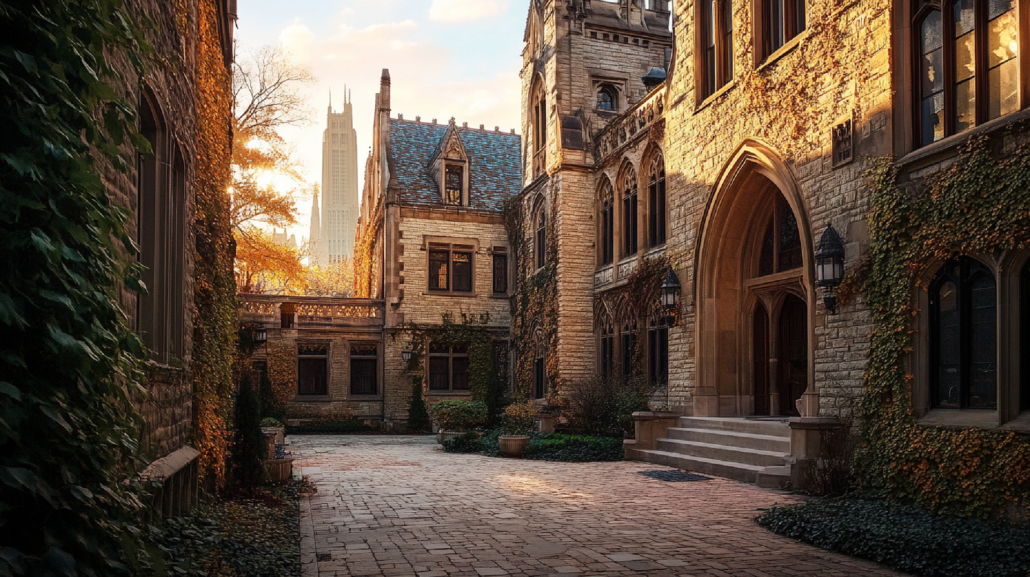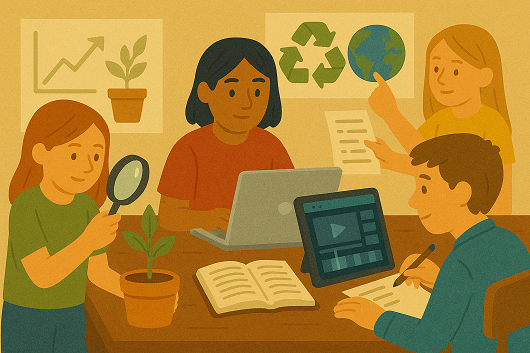Top Boarding Schools in the US with the Best STEM Programs

Not all boarding schools are candlelit dorms and dusty textbooks. Some are buzzing hubs of innovation where students go from biology to building robots before you’ve even finished your morning coffee. Across the country, these elite institutions are shaping tomorrow’s engineers, scientists, and software developers. Below is a list of 10 standout boarding schools offering exceptional STEM programs—each one impressive in its own right and not ranked in any particular order.
The Webb Schools, Claremont, CA

Home of the Young Paleontologists
Top School for Paleontology Programs
Tucked into the foothills of the San Gabriel Mountains, The Webb Schools aren’t your typical boarding schools. Sure, they have gorgeous views and small class sizes, but they’re also the only high school in the country with an accredited paleontology museum. Yes, you read that right. Dinosaurs.
Students can enter as early as 9th grade and are immediately swept into a culture of inquiry, discovery, and dirt-under-your-fingernails science. The academic vibe here is adventurous and hands-on, and STEM students thrive in an atmosphere that values both curiosity and precision.
What STEM Programs Does The Webb Schools Offer?
- Raymond M. Alf Museum of Paleontology: Webb’s on-campus museum gives students exclusive access to real fossil digs and professional paleontology work. Every freshman joins the Peccary Society, meaning fossil expeditions in the California desert aren’t just for grad school anymore.
- Advanced Science Research Program: Junior and senior students can work closely with faculty mentors to conduct original, college-level scientific research in biology, physics, or environmental science. It’s a rare opportunity for high schoolers to publish or present their work before even applying to college.
- Robotics Team: The FIRST Robotics Competition at Webb brings together coding, engineering, and teamwork. Any student can join, regardless of grade level or experience, and learn to design, build, and program robots for national-level competitions.
The Hill School, Pottstown, PA

Home of the Scientific Trailblazers
Independent Research Opportunities in STEM at The Hill School
The Hill School feels like a postcard from a classic boarding school movie, but behind its ivy-covered walls is a thoroughly modern approach to STEM education. Students begin in grade 9 and quickly get the sense that learning here isn’t confined to the classroom. Labs, makerspaces, and mentorships are all part of the academic DNA.
Hill fosters a culture of independent thought and multidisciplinary learning. Whether you’re interested in environmental science or robotics, there’s room to dig deep.
What STEM Programs Does The Hill School Offer?
- The Quadrivium Program: Hill’s signature STEM and humanities hybrid. Students accepted into the program (typically by application in their sophomore year) follow a curated interdisciplinary pathway that blends science, math, philosophy, and ethics. Perfect for the student who wants to question both how the world works and why.
- IDEA Lab (Innovation, Design, Engineering, Application): This state-of-the-art makerspace is open to all students, offering 3D printers, laser cutters, and a host of fabrication tools. Classes in engineering, design thinking, and programming happen here, and students are encouraged to pitch and prototype their own projects.
- Robotics & Engineering Courses: Electives for all grade levels allow students to explore Arduino, circuitry, and mechanical design. The Hill Robotics Club also competes in VEX competitions, welcoming both seasoned builders and brand-new tinkerers.
Cranbrook Schools, Bloomfield Hills, MI

Home of the STEM Artists
Top School for STEM and Arts Integration
Cranbrook looks more like a modern art museum than a school, which makes sense, considering it’s home to one. Students who start in grades 9 or 10 find themselves immersed in a campus that values both precision and creativity. Here, STEM is never isolated. It’s woven through the arts, architecture, and humanities in ways that make for some seriously cool cross-disciplinary learning.
From dissecting frogs to coding interactive art installations, there’s something for every curious mind.
What STEM Programs Does Cranbrook Schools Offer?
- Cranbrook Institute of Science: The school’s on-campus science museum opens its labs to student researchers. Whether you’re analyzing meteorite fragments or studying freshwater ecosystems, this is hands-on science with real-world implications.
- STEM+ Curriculum: Emphasizing cross-pollination between disciplines, students can dive into courses that blend programming with design, biology with sculpture, and chemistry with environmental justice. These are not your average electives—they’re creative, innovative, and open to all grade levels.
- Summer STEM Enrichment: For those who want to keep tinkering through July, Cranbrook offers week-long themed camps in robotics, space science, and engineering. While not mandatory, they attract some of the most passionate students—and offer a great on-ramp to more advanced projects during the year.
The Hotchkiss School, Lakeville, CT

Home of the Green Engineers
Sustainability in STEM Education at Hotchkiss School
Hotchkiss is where New England charm meets a serious sustainability agenda. Set among the rolling hills of Connecticut, it’s a place where students debate philosophy one hour and install solar panels the next. With entry in grades 9 and 10, Hotchkiss attracts students who want both deep intellectual engagement and real-world application.
STEM at Hotchkiss is collaborative, globally aware, and often literally grown on the school’s own farm.
What STEM Programs Does The Hotchkiss School Offer?
- Fairfield Farm Ecosystem and Adventure Team (FFEAT): A one-of-a-kind opportunity for students to get involved in sustainable agriculture and renewable energy research. Open to all grade levels, the program includes beekeeping, environmental sensor installation, and even farm-to-table data analysis.
- Environmental Science & Engineering Pathway: A suite of classes focused on environmental challenges, renewable technology, and sustainable systems design. Students can specialize in clean energy, hydrology, or systems modeling.
- Hotchkiss Robotics and Design Studio: A bright, modern lab where students build robots, prototype inventions, and test engineering ideas. Courses in computer-aided design and mechanical systems are open as electives starting in the sophomore year, and the Robotics Club welcomes beginners.
St. Paul’s School, Concord, NH

Home of the Aquatic Scientists
Top School for Marine and Freshwater Biology
St. Paul’s is a fully residential school that offers students the rare experience of living, learning, and leading in a close-knit academic village. Entry starts in grade 9, and the school sits on over 2,000 acres of New Hampshire woodlands, lakes, and streams. Translation: Natural science is everywhere.
STEM at St. Paul’s isn’t just in labs—it’s out in the field, in the water, and under the stars.
What STEM Programs Does St. Paul’s School Offer?
- Marine & Freshwater Biology Program: Students explore aquatic ecosystems right on campus. Field research is a core part of the curriculum, with real data collection happening just a few steps from the classroom. Available to juniors and seniors, but younger students can participate through club projects and summer experiences.
- Collaborative Science Building: Open to all grades, this facility features lab spaces for chemistry, physics, and bioengineering. Faculty encourage experimentation, invention, and independent inquiry starting freshman year.
- Advanced Robotics & Programming: Students can choose from electives like App Development, Python, and Engineering Design. The school also hosts a Robotics Club that builds competitive bots and explores everything from artificial intelligence to drone flight.
Choate Rosemary Hall, Wallingford, CT

Home of the Budding Innovators
Top Boarding School for STEM Innovation
Choate feels like the boarding school version of a tech incubator: polished, sharp, and teeming with potential. Students usually enter in grades 9 or 10 and immediately find themselves immersed in a high-energy academic community where big ideas are not just encouraged—they’re expected.
Choate’s campus buzzes with innovation. From its eco-conscious environmental center to its shiny new innovation lab, the school is a launchpad for ambitious students who want to explore science, tech, and engineering from every angle.
What STEM Programs Does Choate Rosemary Hall Offer?
- Science Research Program (SRP): Juniors and seniors with a serious interest in science can apply to this competitive program to pursue original, independent research. Working under faculty guidance, students design and conduct experiments, analyze data, and present their findings in symposia that would make grad students jealous.
- Kohler Environmental Center (KEC): This isn’t just a green building—it’s an entire sustainability ecosystem. Students live and study at the KEC while conducting environmental science research using solar panels, composting systems, and permaculture gardens as their laboratory.
- Robotics & Technology Curriculum: From Intro to Engineering Design to Advanced Robotics, Choate offers a broad range of electives that let students get hands-on with fabrication, coding, and automation. And yes, there’s a competitive robotics team—open to any student with a passion for problem-solving.
The Lawrenceville School, Lawrenceville, NJ

Home of the Data Detectives
The Lawrenceville School, NJ: Inquiry-Based STEM Education
Step onto Lawrenceville’s leafy campus and you might think you’ve wandered into a small liberal arts college. That’s no accident. With its interdisciplinary curriculum, Harkness discussion tables, and emphasis on student-led inquiry, Lawrenceville is training students to think deeply and ask the tough questions.
Students enter grade 9 and are immediately looped into a culture that prizes not only academic achievement but also intellectual independence. STEM here is collaborative, inquiry-based, and often peppered with real-world applications.
What STEM Programs Does The Lawrenceville School Offer?
- Hutchins Scholars in Science Research: By application only, this program supports select students conducting intensive, year-long research projects. With access to professional-grade lab equipment and mentorship from university-level researchers, students regularly compete in national science fairs and publish original findings.
- Big Data & Artificial Intelligence Electives: These aren’t your average coding classes. Students can dive into data visualization, machine learning models, and ethical implications of tech, all through dynamic electives open by junior year.
- The Gruss Center for Art and Design (GCAD): A high-tech playground for makers and doers, GCAD includes a robotics lab, recording studio, and fabrication space where students bring their wildest engineering dreams to life. It’s open to all grade levels with no prior experience required.
Phillips Exeter Academy, Exeter, NH

Home of the Code Enthusiasts
Top School for Mathematics & Science for Minority Students (MS)
Exeter isn’t just famous for inventing the Harkness method. It’s also a STEM wonderland where collaboration rules and competition take a backseat to curiosity. Students typically begin in grades 9 or 10, and every class, yes, even multivariable calculus, is built around a round table.
The vibe here is equal parts scholarly and exploratory. If you want to get philosophical about computer science or launch a weather balloon with your physics class, this is your jam.
What STEM Programs Does Phillips Exeter Academy Offer?
- Computer Science Curriculum: Exeter offers a full sequence from Intro to Programming up to Artificial Intelligence and Advanced App Design. Most courses are open to all students, depending on placement, so if you’re a freshman ready for machine learning, go for it.
- Exeter Math Institute: With one of the deepest high school math departments in the country, students can explore pure and applied math through electives like combinatorics, cryptography, and linear algebra. The math curriculum often partners with science departments for interdisciplinary challenges.
- Summer STEM Research Fellowships: These competitive fellowships allow students to conduct original research under faculty supervision during the summer, often in biology, chemistry, or engineering. Great for students who want lab coats with their beach towels.
Phillips Academy Andover, Andover, MA

Home of the Future Scientists
Top School for Mathematics & Science for Minority Students (MS)
Andover is a storied school with a progressive heart. Students begin in grade 9 or 10 and are welcomed into an academic community that’s as intellectually intense as it is forward-thinking. The school’s motto—non sibi, or “not for self”—applies to its STEM curriculum too: the goal is to empower students to solve real-world problems. The facilities are world-class, the science programs cutting-edge, and the opportunities for research and application nearly endless.
What STEM Programs Does Phillips Academy Andover Offer?
- Mathematics & Science for Minority Students (MS): This selective summer program supports high-achieving students of color from underserved communities with three summers of advanced science and math instruction. It’s intensive, immersive, and often life-changing.
- The Tang Institute: A living laboratory for innovation in education, the Tang Institute funds and supports student-led research projects across disciplines—including tech, sustainability, and digital media. Any student with a big idea can pitch a project and get mentorship and resources to bring it to life.
The Thacher School, Ojai, CA

Home of the Stargazing Scholars
Top School for Astronomy Programs and Observatories
Thacher might be known for its equestrian program and outdoor ethos, but don’t let the rustic charm fool you—this is one of the most ambitious, STEM-forward boarding schools in the country. Nestled in the Topatopa Mountains, it offers a hands-on, earth-connected approach to academics with a serious side of data analysis and telescope time.
Students enter grade 9 and are instantly absorbed into a tight-knit community where academic support is as personal as it is powerful.
What STEM Programs Does The Thacher School Offer?
- Thacher Observatory & Astronomy Program: Students have access to professional-grade telescopes and participate in long-term observation projects. Courses in astronomy and astrophysics make use of real-time data collection, and the observatory is open to all students starting in the sophomore year.
- Independent STEM Research: Thacher offers students the ability to partner with faculty or even local universities like Caltech for guided research in fields such as biology, computer science, and environmental science. Juniors and seniors can propose projects and earn credit for their work.
- Intro to Engineering & Robotics Curriculum: With a design-oriented focus, students learn to code, prototype, and build functional machines in Thacher’s dedicated makerspace. Open to all students, these classes lead directly into competitive robotics and AI electives.
Need Help? Cardinal Education Can Lend a Hand!
Boarding schools are notorious for their competitive admissions. That’s why we always strive to help students and their families the best way we can. Here at Cardinal Education, we offer help by giving you the necessary skills to succeed in your academic journey. With academic coaching and test prep, we also have dedicated SSAT Practice Tests and ISEE Practice Tests, as well as SSAT Prep materials and ISEE prep materials. We ensure students are in the best shape to tackle any tasks! Contact us today and let our experts guide you!
Like what you see here? We are happy to permit you to use our material as long as you link back! Please refer to us as the Cardinal Education Blog.
Related Articles
The Very Best Boarding Schools In America
What International Families Should Know About U.S. Boarding Schools
Step-by-Step Parents’ Guide to the Boarding School Admissions Process
Frequently Asked Questions
- What boarding school offers electives specifically focused on engineering?
If your idea of fun involves CAD software and circuit boards, you’re in luck. Schools like Choate Rosemary Hall, The Hill School, and The Thacher School offer electives that dive straight into the world of engineering. Whether it’s “Intro to Engineering Design,” mechanical systems, or full-blown robotics labs, students can get their hands dirty designing real things that actually work. You’ll find classes with names that sound more like college electives than high school coursework. And yes, they’ll let you wield a soldering iron. These programs are open to beginners and advanced tinkerers alike, so curiosity is the only real prerequisite.
- What boarding schools offer programs about AI?
If artificial intelligence makes your brain light up like a chatbot with a sugar rush, schools like Phillips Exeter, Lawrenceville, and Choate are definitely worth a look. They’re weaving AI into their computer science curriculum with electives that explore neural networks, machine learning, and even the ethics of tech. Some schools introduce AI through interdisciplinary courses, combining it with data visualization or social science. Others offer advanced tracks with real projects, Python coding, and algorithm building. No need to wait for college to geek out over generative models or decision trees—AI is already part of the academic DNA at these tech-forward campuses.
- What boarding schools offer internships in STEM fields?
Yes, some boarding schools actually give you the chance to intern in a lab while your peers are scooping ice cream all summer. Phillips Academy Andover offers opportunities through its STEM Scholar initiatives, while Lawrenceville’s Hutchins Scholars often find placements in university labs or field research programs. At Choate, students in the Science Research Program get help connecting with mentors outside the school, sometimes even landing roles in real-world laboratories. These aren’t the type of internships where you fetch coffee. We’re talking DNA sequencing, environmental data collection, and software prototyping. So if you want to build your resume while still in high school, these schools deliver.
- Can I apply to a different school's STEM programs while still being enrolled in my current school?
Generally, nope. These schools want you in the lab and living in the dorms. Most STEM signature programs—like Choate’s SRP or Webb’s fossil digs—are reserved for enrolled students. That’s because the programs are embedded into the full academic schedule and campus life. You’re not just dropping by for robotics after hours. That said, a few schools offer summer programs or open-enrollment experiences, like Andover’s (MS ² or Exeter Summer, which welcome outside applicants. So while you can’t moonlight in another school’s engineering class during the school year, summer might just be your golden ticket to sneak into the STEM scene.



